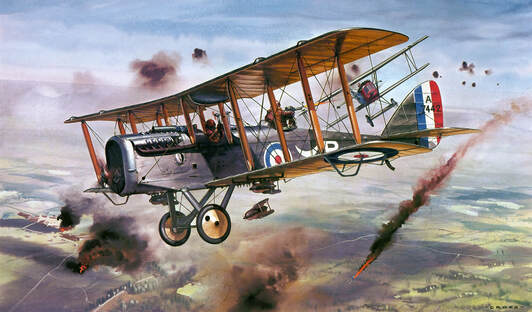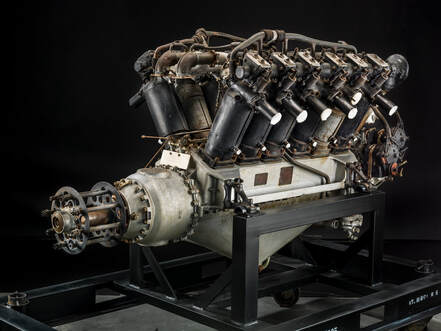 Airco DH4 (Roy Cross)
Airco DH4 (Roy Cross)
The Airco DH4
The Airco DH.4 was a two-seat biplane day bomber from the First World War, and designed by Geoffrey de Havilland for Airco. It was a groundbreaking aircraft - the first British two-seat light day-bomber with self-defense capabilities.
Initially intended to be powered by the 160 hp (120 kW) Beardmore Halford Pullinger (BHP) engine, the DH.4 encountered engine-related issues. As a result, various other engines were utilized, with the 375 hp (280 kW) Rolls-Royce Eagle engine proving to be the most successful. The DH.4 took its inaugural flight in August 1916 and became operational in France in March 1917, less than a year later. Of the 6,295 aircraft built, 4,846 were manufactured in the United States, for the American expeditionary forces in France.
After the Armistice in November 1918, many DH.4s were sold to civilian operators, who found them particularly useful as mailplanes. Modified versions of the DH-4 were also employed for early commercial passenger airplane services in Europe. War-surplus DH4s played a vital role in emerging air forces worldwide. The U.S. Army had several companies re-manufacture its remaining DH4s, and these aircraft remained in operational service until the early 1930s.
The Airco DH.4 was a two-seat biplane day bomber from the First World War, and designed by Geoffrey de Havilland for Airco. It was a groundbreaking aircraft - the first British two-seat light day-bomber with self-defense capabilities.
Initially intended to be powered by the 160 hp (120 kW) Beardmore Halford Pullinger (BHP) engine, the DH.4 encountered engine-related issues. As a result, various other engines were utilized, with the 375 hp (280 kW) Rolls-Royce Eagle engine proving to be the most successful. The DH.4 took its inaugural flight in August 1916 and became operational in France in March 1917, less than a year later. Of the 6,295 aircraft built, 4,846 were manufactured in the United States, for the American expeditionary forces in France.
After the Armistice in November 1918, many DH.4s were sold to civilian operators, who found them particularly useful as mailplanes. Modified versions of the DH-4 were also employed for early commercial passenger airplane services in Europe. War-surplus DH4s played a vital role in emerging air forces worldwide. The U.S. Army had several companies re-manufacture its remaining DH4s, and these aircraft remained in operational service until the early 1930s.
 Rolls-Royce Eagle at the National Air and Space Museum
Rolls-Royce Eagle at the National Air and Space Museum
The Beginning
Geoffrey de Havilland designed the DH4 as a lightweight two-seat combat aircraft capable of performing day bombing and aerial reconnaissance missions.
In August 1916, the first prototype DH.4 conducted its maiden flight using a 230 hp (170 kW) BHP engine. Initial flight tests demonstrated favorable handling and performance. The Central Flying School (CFS) evaluated the prototype and reported positive findings, highlighting its stability, light controls, and comfortable crew positions. The prototype achieved exceptional time-to-altitude figures, surpassing its predecessors. However, issues with the BHP engine necessitated significant redesign work before entering production.
During the prototype's flight trials, no definite plans were made for the mass production of the BHP engine. Coincidentally, the water-cooled Rolls-Royce Eagle inline engine, which shared a similar configuration to the BHP engine, was nearing the end of its development. The Royal Flying Corps (RFC) was impressed by the DH.4's performance and placed an initial order in late 1916. The Royal Navy also showed interest and ordered a pair of prototypes for evaluation. The production DH4s for the RFC were powered by 250 hp (190 kW) Eagle III engines and featured armament such as a Vickers machine gun and a Lewis gun.
The American DH-4
During World War I, the United States Army Air Service faced a significant challenge - a lack of suitable frontline combat aircraft. In response, the U.S. turned to its allies, particularly Britain and France, to procure aircraft that could meet its needs. One such aircraft was the renowned DH.4, which was adapted and manufactured in the United States under the designation "DH-4." This American variant, produced mainly by Dayton-Wright and Fisher Body, played a vital role in American aviation during and after the war.
Geoffrey de Havilland designed the DH4 as a lightweight two-seat combat aircraft capable of performing day bombing and aerial reconnaissance missions.
In August 1916, the first prototype DH.4 conducted its maiden flight using a 230 hp (170 kW) BHP engine. Initial flight tests demonstrated favorable handling and performance. The Central Flying School (CFS) evaluated the prototype and reported positive findings, highlighting its stability, light controls, and comfortable crew positions. The prototype achieved exceptional time-to-altitude figures, surpassing its predecessors. However, issues with the BHP engine necessitated significant redesign work before entering production.
During the prototype's flight trials, no definite plans were made for the mass production of the BHP engine. Coincidentally, the water-cooled Rolls-Royce Eagle inline engine, which shared a similar configuration to the BHP engine, was nearing the end of its development. The Royal Flying Corps (RFC) was impressed by the DH.4's performance and placed an initial order in late 1916. The Royal Navy also showed interest and ordered a pair of prototypes for evaluation. The production DH4s for the RFC were powered by 250 hp (190 kW) Eagle III engines and featured armament such as a Vickers machine gun and a Lewis gun.
The American DH-4
During World War I, the United States Army Air Service faced a significant challenge - a lack of suitable frontline combat aircraft. In response, the U.S. turned to its allies, particularly Britain and France, to procure aircraft that could meet its needs. One such aircraft was the renowned DH.4, which was adapted and manufactured in the United States under the designation "DH-4." This American variant, produced mainly by Dayton-Wright and Fisher Body, played a vital role in American aviation during and after the war.
 The 1000th American "Liberty Plane".
The 1000th American "Liberty Plane".
The American DH-4 inherited many design features from its British predecessor but received modifications to meet the specifications of the United States Army Air Service. Notably, it was powered by the reliable 400-horsepower Liberty L-12 engine, which was readily available in the U.S. This enhancement significantly improved the aircraft's performance, making it a formidable combat machine.
In May 1918, the first American-built DH-4 was delivered to France, marking the beginning of combat operations in August of that year.
Although the Liberty engine slightly diminished its performance compared to the Rolls-Royce-powered version, the DH-4, known as the "Liberty Plane," became the standard general-purpose two-seater for the U.S. Army Air Service, garnering popularity among its crews.
The American DH-4 played a crucial role during the First World War, with four Medals of Honor awarded to aircrew operating this aircraft. Following the end of the war, surplus DH-4s were abundant, while the improved DH-4B variant remained available. Consequently, the decision was made not to transport these aircraft back across the Atlantic. Instead, remaining DH-4s, along with other obsolete observation and trainer aircraft, were burned in what became known as the "Billion Dollar Bonfire" in France. The DH-4s that remained formed a substantial part of American air strength for several years, serving various roles. In fact, over 60 variants were produced, demonstrating the adaptability of this aircraft.
The DH-4 also contributed to significant advancements in aviation technology. It served as a platform for experimental flying, engine tests, and the initial trials of air-to-air refueling in 1923. Notably, a DH-4 accomplished a record-breaking endurance flight of 37 hours and 15 minutes, setting multiple distance, speed, and duration records through 16 mid-air refuelings.
In May 1918, the first American-built DH-4 was delivered to France, marking the beginning of combat operations in August of that year.
Although the Liberty engine slightly diminished its performance compared to the Rolls-Royce-powered version, the DH-4, known as the "Liberty Plane," became the standard general-purpose two-seater for the U.S. Army Air Service, garnering popularity among its crews.
The American DH-4 played a crucial role during the First World War, with four Medals of Honor awarded to aircrew operating this aircraft. Following the end of the war, surplus DH-4s were abundant, while the improved DH-4B variant remained available. Consequently, the decision was made not to transport these aircraft back across the Atlantic. Instead, remaining DH-4s, along with other obsolete observation and trainer aircraft, were burned in what became known as the "Billion Dollar Bonfire" in France. The DH-4s that remained formed a substantial part of American air strength for several years, serving various roles. In fact, over 60 variants were produced, demonstrating the adaptability of this aircraft.
The DH-4 also contributed to significant advancements in aviation technology. It served as a platform for experimental flying, engine tests, and the initial trials of air-to-air refueling in 1923. Notably, a DH-4 accomplished a record-breaking endurance flight of 37 hours and 15 minutes, setting multiple distance, speed, and duration records through 16 mid-air refuelings.
General Characteristics
Performance
- Crew 2 (pilot and observer/gunner)
- Length 30 ft 8 in (9.35 m)
- Wingspan 42 ft 4 in (12.90 m)
- Height 11 ft 10 in (3.61 m)
- Wing Area 410 sq ft (38.1 m2)
- Empty Weight 2,387 lb (1,083 kg)
- Gross Weight 3,465 lb (1,573 kg)
- Max Take Off Weight 3,790 lb (1,720 kg)
- Powerplant 1 × Rolls-Royce Eagle VIII water-cooled V-12 engine, 375 hp (280 kW)
Performance
- Maximum Speed 143 mph (230 km/h or 124 knots) at sea level
- Cruise Speed 100–110 mph (160–177 km/h or 87–96 knots)
- Range 300 mi (480 km, 260 nautical miles)
- Service Ceiling 19,000 ft (5,800 m)
- Rate of Climb 1,000 ft/min (5.1 m/s)
- Wing Loading 8.4 lb/sq ft (41 kg/m2)
- Power/Mass 0.11 hp/lb (0.18 kw/kg)


